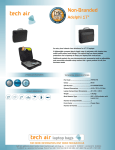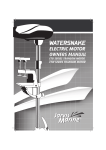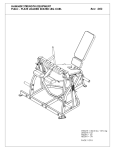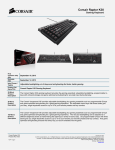Download Pyle PSS6
Transcript
HIGHPOWERSTEREOSPEAKERSELECTOR MODEL:PSS4/PSS6 www.pyleaudio.com Thank you for purchasing PYLE PRO Multi-Speaker Selectors. It lets you connect up to four (PSS4) or six (PSS6) separate pairs of speakers to your stereo receiver/amplifier. The control center is especially convenient if you have speaker sets in different rooms and want to turn them on and off independently. You can enjoy the convenience and flexibility of listening to multiple speaker pairs simultaneously. The control center lets you use one to four (PSS4) or six (PSS6) sets of speakers at a time, and is designed to operate with a stereo receiver/amplifier that has a maximum of 100 watts per channel, and with speaker systems that have a minimum impedance of 8 ohms (see “Impedance Chart” on page 5) 1 PREPARATIONS • Use the PYLE PRO Speaker Selectors only with amplifiers rated at 100 watts per channel or less. • Your PYLE PRO Speaker Selector is designed to accept any size cable up to 14 gauge non-terminated speaker wire. If you’re using non-terminated speaker wire, do not use any speaker wire that is larger than 14 gauge. The lower the gauge number, the larger the cable (e.g., 12 gauge is larger in actual physical size than 14 gauge). • Do not hook the outputs of one selector into the inputs of another speaker selector together. MAKINGTHECONNECTIONS The control center divides the power from your receiver/amplifier differently to its speaker terminals. (This is especially noticeable when you connect only one pair of speakers. If you connect more than one pair of speakers, see “Impedance Chart” on page 5 to selector the best terminals to connect.) For the best performance, make the connections based on how frequently you use each set of speakers. Cautions:To avoid damaging your speakers or receiver/amplifier: • Be sure your receiver/amplifier’s power is turned off before you make the connections. • Never let the speaker wire’s bare ends touch each other or the adjacent terminals on the control center. • Do not connect more than one pair of sepakers to each set of terminals. 2 Press open the desired SPK terminals on the control center. Insert the speakers’ positive (+) wires in the positive (red) terminals, and negative (-) wires into the nagative (black) terminals, according to the respective L (left) and R (right) terminals. Then press the tabs to close them. Press open the AMP terminals on the control center, then insert your receiver/amplifier’s positive (+) wires into the positive (red) terminals, and negative (-) wires in the nagative terminals. Then press the tabs to close them. 3 Notes: • If your receiver/amplifier has more than one set of speaker terminal (A and B), connect only one or the other to the control center. • For the best results, we recommend 14-gauge, two conductor speaker wire (not supplied) for most connections. If you plan to located the speakers further than 80 feet from the control center, use a heavier gauge of wire. OPERATION Caution:To avoid damaging your receiver/amplifier, set its volume to the lowest setting before changing the control center’s settings. To turn on a pair of speakers connected to the control center, simply press in the desired button. For example, to turn on the set of speakers connected to SPK A, press A. To turn off a pair of speakers, press the button again so it is in the “out” position. Note:if no speakers are connected to a set of terminals, do not press in the corresponding control button. 4 IMPEDANCECHART Impedance is a measurement of the load placed on your receiver/amplifier by the speakers. The load placed on your receiver/amplifier from thte control center will vary depending on how many pairs of speakers you turn on at one time, and on which speakers you turn on. The chart below shows the impedance for all possible combinations of 8-ohm speakers. PSS6 PSS4 Speaker Sets On Speaker Sets On Impedance (Ω) Impedance (Ω) A, B, C or D 8 A, B, C, D, E or F 8 A+B, A+C, A+D B+C, B+D, C+D 4 A+B, A+C, A+D A+E, A+F, B+C B+D, B+E, B+F C+D, C+E, C+F, E+F 4 A+B+C, A+B+D A+C+D, B+C+D 3.1 A+B+C+D 2.4 A+B+C, A+B+D, A+B+E A+B+F, A+C+D, A+C+E A+C+F, A+D+E, A+D+F A+E+F, B+C+D, B+C+E B+C+F, B+D+E, B+D+F C+D+E, C+D+F, D+E+F 3.1 A+B+C+D, A+B+C+E A+B+C+F, A+C+D+E A+C+D+F, A+D+E+F B+C+D+E, B+C+D+F C+D+E+F 2.4 A+B+C+D+E+F 1.7 5 SPECIFICATIONS Audio Power Handling Frequency Response Channel Separation Crosstalk between channels Speaker terminal wire size requirements Dimensions (WxHxD) Weight 50W (R.M.S.)/ch, 100W (Max)/ch 20 Hz to 20KHz 80 dB 50 dB 14-22 awg 190x50x120 mm (PSS4) 250x50x150 mm (PSS6) 0.81kgs (1.79lbs) (PSS4) 1.15kgs (2.54lbs) (PSS6) 6













